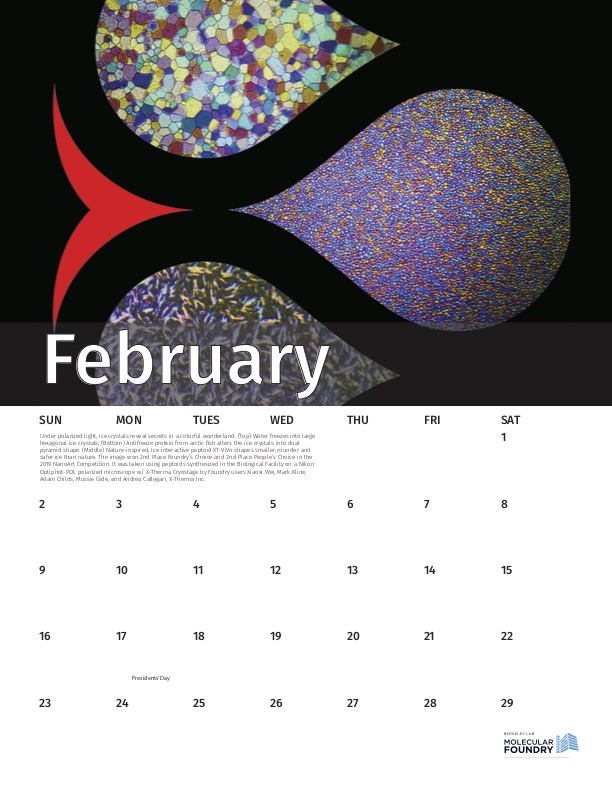Featuring the winning entries along with other compelling images submitted to the 2019 NanoArt Image Contest, the Foundry’s 2020 calendar features work from Foundry staff and users spanning all seven of the Foundry’s technical facilities.
Download and print your own copy!
About the 2020 Calendar

January
This spin-polarized LEEM image shows ultra-thin cobalt islands on an Ru(0001) crystal. The colorized areas highlight magnetic domain structures with various orientations. This material is used in magnetic memory or logic devices. The image was taken on the SPLEEM at NCEM by Foundry user Gong Chen of UC Davis and won 1st Place Foundry’s Choice in the 2019 NanoArt Image Contest.

February
Under polarized light, ice crystals reveal secrets in a colorful wonderland. (Top) Water freezes into large hexagonal ice crystals; (Bottom) Antifreeze protein from arctic fish alters the ice crystals into dual pyramid shape. (Middle) Nature-inspired, Ice-interactive peptoid XT-ViVo shapes smaller, rounder and safer ice than nature. The image won 2nd Place Foundry’s Choice and 2nd Place People’s Choice in the 2019 NanoArt Competition. It was taken using peptoids synthesized in the Biological Facility on a Nikon Optiphot-POL polarized microscope w/ X-Therma Cryostage by Foundry users Xiaoxi Wei, Mark Kline, Adam Childs, Mussie Gide, and Andrea Callegari, X-Therma Inc.

March
Researchers used an improved method to coat a monolayer of upconverting nano-disks on the surface of BaTiO3 micro-cavities to generate high quality microlasers. The method can improve the quality of the micro-cavities, lower the lasing threshold, and results in sharper lasing peaks. The material was created in the Inorganic Nanostructures facility and imaged on the ULTRA 55 – FESEM in the Imaging facility by Foundry users and staff: Yawei Liu, Ayelet Teitelboim, and Emory M. Chan. The image, submitted by Yawei Liu, won 3rd Place Foundry’s Choice in the 2019 NanoArt Image Contest.

April
This is a scanning tunneling microscopy image of tungsten disulfide showing the atomic scale electronic structure. A single sulfur atom has been replaced by a carbon atom causing a dramatic change in the local electronic environment, resulting in this fiery cloud of electrons. Atomically thin WS2 has many different applications, from QIS to flexible electronics. The image was taken on the low temperature scanning tunneling microscope in the Imaging facility by Foundry users and staff: Katherine A. Cochrane, Bruno Schuler, and Alex Weber-Bargioni. The image won 4th place Foundry’s Choice in the 2019 NanoArt Image Contest.

May
This image shows a polymer electrolyte film which can be used to prepare lithium-metal batteries. It consists of two kinds of linked long-chained molecules which assemble into ordered, interpenetrating structures. The image was colored to accentuate the sample’s intricate morphology and a defect in the film which stems from the casting process. The image won 1st place People’s Choice in the 2019 NanoArt Image Contest. The sample was prepared by Foundry user Jacqueline Maslyn from the group of Prof. Nitash Balsara and the micrograph was taken by user Alexander Müller from the group of Prof. Andrew Minor at NCEM.

June
Turning over a new LEAF in perovskite research: researchers developed RAPID (Robot-Accelerated Perovskite Investigation and Discovery) that accelerates discovery of metal halide perovskite materials. The image shows butane-1,4-diammonium lead iodide crystals that could be used in photovoltaics, LEDs, and lasers. The material was created in the Inorganic Facility and the image obtained using an optical microscope by Mansoor Ani Najeeb, Zhi Li, Joshua Schrier, Alexander J. Norquist, and Emory M. Chan. The image was submitted by Zhi Li and won 3rd Place People’s Choice in the 2019 NanoArt Image Contest.

July
Elecrostatically actuated nanoneedles for massively parallelized precision gene editing on a chip. Precise gene editing of clinically relevant cells for gene therapies on a scalable chip. The precision and scalability of semiconductor manufacturing is applied to the application space of cell reprogramming to cure disease and power fundamental biological discoveries. Work by Foundry industry users Mark Webb and the Mekonos Team using the Foundry’s Nanofabrication Facility.

August
Peptoid diblock copolymers as short as 10 monomers long, self assemble into monolayer nanosheets with crystalline order. New cryo-EM imaging techniques were developed that allow us to easily resolve individual molecules (wedge-shaped white areas). Computer modeling the peptoids atoms into these shapes provides a detailed atomic model (green) of the peptoid lattice, including the ability to see individual bromine atoms (magenta) for the first time in a soft material. Work by Foundry users and staff: Sunting Xuan, Xi Jiang, Ryan K. Spencer, Nan K. Li, David Prendergast, Nitash P. Balsara, Ronald N. Zuckermann using the Foundry’s Theory and Biological Facilities.

September
The micromachining capability of the laser used for this image allows us to produce nanoscale electrodes and specialized AFM resonators. The polymer featured here exhibits both chemical resistance and electrical insulation for a variety of applications. Work by Foundry industry users Hilary Brunner, Christina Newcomb, and Dominik Ziegler from Scuba Probe Technologies using the Foundry’s Nanofabrication Facility.

October
Live mouse brain slice labeled with quantum dots functionalized with a cocaine analog that binds to dopamine transporters. Quantum dots are red and neurons are lightly counter-stained blue. Mutations in these dopamine transporters have been implicated in autism. The functionalized quantum dots attach specifically to these transporters to enable tracking of single transporters at both high spatial (20 nm resolution) and temporal (millisecond timescales) resolution in acute striatal brain slices. Work by Foundry users Lucas Thal, Sandy Rosenthal, Victor Mann and Foundry staff Bruce Cohen; using the Foundry’s Biological Facility.

November
A metal organic framework (MOF) material that has great potential to be used as a hydrogen storage material to power cars and machines. Work by Foundry user Han Wang using the Foundry’s Theory Facility.

December
Spontaneous crystallization of organic semiconductor molecules into fractal patterns, as seen in this polarized optical microscopic image. These crystals can be ink-jet printed for use in flexible electronics. Work by Foundry user Christopher L. Anderson using the Foundry’s Organic Facility.


